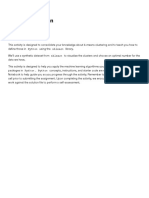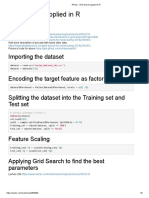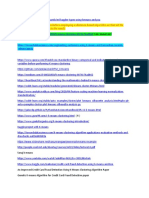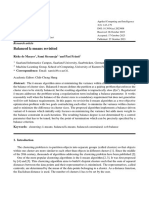Pyspark - Kmeans Clustering With Map Reduce in Spark - Stack Overflow
Uploaded by
jefferyleclercPyspark - Kmeans Clustering With Map Reduce in Spark - Stack Overflow
Uploaded by
jefferyleclerc3/9/24, 5:41 AM pyspark - Kmeans clustering w ith map reduce in spark - Stack Overflow
Kmeans clustering with map reduce in spark
Asked 2 years, 2 months ago Modified 2 years, 2 months ago Viewed 822 times
Hello can someone help me to do map reduce with Kmeans using Spark . Actually can do Kmeans with spark , but i dont how to map
and reduce it . Thanks .
2
apache-spark pyspark mapreduce k-means
Share Improve this question Follow asked Dec 11, 2021 at 16:55
Ibrahim Ahmed-Nour
29 1
2 Answers Sorted by: Highest score (default)
Below a proposed pseudo-code for your exercise:
centroids = k random sampled points from the dataset
1
Map:
Given
By clicking a point
“Accept and theyou
all cookies”, setagree
of centroids
Stack Exchange
can store cookies on your device and disclose information in
Calculate
accordance with ourthe distance
Cookie Policy.between the point and each centroid
Emit the point and the closest centroid
Accept all cookies Necessary cookies only
Reduce:
Customize settings
Given the centroid and the points belonging to its cluster
Calculate the new centroid as the arithmetic mean position of the points
https://stackoverflow .com/questions/70317122/kmeans-clustering-w ith-map-reduce-in-spark 1/6
3/9/24, 5:41 AM pyspark - Kmeans clustering w ith map reduce in spark - Stack Overflow
Emit the new centroid
prev_centroids = centroids
centroids = new_centroids
while prev_centroids - centroids > threshold
The mapper class calculates the distance between the data point and each centroid. Then emits the index of the closest centroid and
the data point:
class MAPPER
method MAP(file_offset, point)
min_distance = POSITIVE_INFINITY
closest_centroid = -1
for all centroid in list_of_centroids
distance = distance(centroid, point)
if (distance < min_distance)
closest_centroid = index_of(centroid)
min_distance = distance
EMIT(closest_centroid, point)
The reducer calculates the new approximation of the centroid and emits it.
class REDUCER
method REDUCER(centroid_index, list_of_point_sums)
number_of_points = partial_sum.number_of_points
point_sum = 0
for all partial_sum in list_of_partial_sums:
By clicking “Accept all cookies”,
point_sum you agree Stack Exchange
+= partial_sum
point_sum.number_of_points
can store cookies += partial_sum.number_of_points
on your device and disclose information in
accordancecentroid_value = point_sum / point_sum.number_of_points
with our Cookie Policy.
EMIT(centroid_index, centroid_value)
The actual K-Means Spark implementation:
First you read the file with the points and generate the initial centroids with a random sampling, using takeSample(False, k): this
function takes k random samples, without replacement, from the RDD; so, the application generates the initial centroids in a
https://stackoverflow .com/questions/70317122/kmeans-clustering-w ith-map-reduce-in-spark 2/6
3/9/24, 5:41 AM pyspark - Kmeans clustering w ith map reduce in spark - Stack Overflow
distributed manner, avoiding to move all the data to the driver. You may reuse the RDD in an iterative algorithm, hence cache it in
memory with cache() to avoid to re-evaluate it every time an action is triggered:
points = sc.textFile(INPUT_PATH).map(Point).cache()
initial_centroids = init_centroids(points, k=parameters["k"])
def init_centroids(dataset, k):
start_time = time.time()
initial_centroids = dataset.takeSample(False, k)
print("init centroid execution:", len(initial_centroids), "in",
(time.time() - start_time), "s")
return initial_centroids
After that, you iterate the mapper and the reducer stages until the stopping criterion is verified or when the maximum number of
iterations is reached.
while True:
print("--Iteration n. {itr:d}".format(itr=n+1), end="\r",
flush=True)
cluster_assignment_rdd = points.map(assign_centroids)
sum_rdd = cluster_assignment_rdd.reduceByKey(lambda x, y: x.sum(y))
centroids_rdd = sum_rdd.mapValues(lambda x:
x.get_average_point()).sortByKey(ascending=True)
new_centroids = [item[1] for item in centroids_rdd.collect()]
stop = stopping_criterion(new_centroids,parameters["threshold"])
n += 1
if(stop == False and n < parameters["maxiteration"]):
centroids_broadcast = sc.broadcast(new_centroids)
else:
By clicking “Accept all cookies”, you agree Stack Exchange
break
can store cookies on your device and disclose information in
accordance with our Cookie Policy.
The stopping condition is computed this way:
def stopping_criterion(new_centroids, threshold):
old_centroids = centroids_broadcast.value
for i in range(len(old_centroids)):
check = old_centroids[i].distance(new_centroids[i],
distance_broadcast.value) <= threshold
https://stackoverflow .com/questions/70317122/kmeans-clustering-w ith-map-reduce-in-spark 3/6
3/9/24, 5:41 AM pyspark - Kmeans clustering w ith map reduce in spark - Stack Overflow
if check == False:
return False
return True
In order to represent the points, a class Point has been defined. It's characterized by the following fields:
a numpyarray of components
number of points: a point can be seen as the aggregation of many points, so this variable is used to track the number of points
that are represented by the object
It includes the following operations:
distance (it is possible to pass as parameter the type of distance)
sum
get_average_point: this method returns a point that has as components the average of the actual components on the number of
the points represented by the object
class Point: def init(self, line): values = line.split(",") self.components = np.array([round(float(k), 5) for k in values])
self.number_of_points = 1
def sum(self, p):
self.components = np.add(self.components, p.components)
self.number_of_points += p.number_of_points
return self
def distance(self, p, h):
if (h < 0):
By clicking “Accept allh cookies”,
= 2 you agree Stack Exchange
return linalg.norm(self.components - p.components, h)
can store cookies on your device and disclose information in
accordance with
defour Cookie Policy.
get_average_point(self):
self.components = np.around(np.divide(self.components,
self.number_of_points), 5)
return self
The mapper method is invoked, at each iteration, on the input file, that contains the points from the dataset
https://stackoverflow .com/questions/70317122/kmeans-clustering-w ith-map-reduce-in-spark 4/6
3/9/24, 5:41 AM pyspark - Kmeans clustering w ith map reduce in spark - Stack Overflow
cluster_assignment_rdd = points.map(assign_centroids)
The assign_centroids function, for each point on which is invoked, assign the closest centroid to that point. The centroids are taken
from the broadcast variable. The function returns the result as a tuple (id of the centroid, point)
def assign_centroids(p):
min_dist = float("inf")
centroids = centroids_broadcast.value
nearest_centroid = 0
for i in range(len(centroids)):
distance = p.distance(centroids[i], distance_broadcast.value)
if(distance < min_dist):
min_dist = distance
nearest_centroid = i
return (nearest_centroid, p)
The reduce stage is done using two spark transformations:
reduceByKey: for each cluster, compute the sum of the points belonging to it. It is mandatory to pass one associative function as
a parameter. The associative function (which accepts two arguments and returns a single element) should be commutative and
associative in mathematical nature
sum_rdd = cluster_assignment_rdd.reduceByKey(lambda x, y: x.sum(y))
mapValues: it is used to calculate the average point for each cluster at the end of each stage. The points are already divided by
key. This trasformation works only on the value of a key. The results are sorted in order to make easier comparisons.
centroids_rdd = sum_rdd.mapValues(lambda x: x.get_average_point()).sortBy(lambda x: x[1].components[0])
By clicking “Accept all cookies”, you agree Stack Exchange
canThe
storeget_average_point()
cookies on your devicefunction returns
and disclose the newincomputed centroid.
information
accordance with our Cookie Policy.
def get_average_point(self):
self.components = np.around(np.divide(self.components,
self.number_of_points), 5)
return self
Share Improve this answer Follow edited Dec 24, 2021 at 15:14 answered Dec 24, 2021 at 14:41
https://stackoverflow .com/questions/70317122/kmeans-clustering-w ith-map-reduce-in-spark 5/6
3/9/24, 5:41 AM pyspark - Kmeans clustering w ith map reduce in spark - Stack Overflow
el_pazzu
85 3 12
You don't need to write map-reduce. You can use spark dataframe API and use Spark ML library.
You can read more about it here.
0
https://spark.apache.org/docs/latest/ml-clustering.html
Share Improve this answer Follow edited Dec 11, 2021 at 18:51 answered Dec 11, 2021 at 18:45
Rahul Kumar
2,234 4 25 52
By clicking “Accept all cookies”, you agree Stack Exchange
can store cookies on your device and disclose information in
accordance with our Cookie Policy.
https://stackoverflow .com/questions/70317122/kmeans-clustering-w ith-map-reduce-in-spark 6/6
You might also like
- Hourglass Workout Program by Luisagiuliet 276% (21)Hourglass Workout Program by Luisagiuliet 251 pages
- The Hold Me Tight Workbook - Dr. Sue Johnson100% (16)The Hold Me Tight Workbook - Dr. Sue Johnson187 pages
- Livingood, Blake - Livingood Daily Your 21-Day Guide To Experience Real Health77% (13)Livingood, Blake - Livingood Daily Your 21-Day Guide To Experience Real Health260 pages
- Shortcut To Shred Ebook Revised 9-9-2015 PDF86% (7)Shortcut To Shred Ebook Revised 9-9-2015 PDF15 pages
- Anastasia: The New Broadway Musical (LIBRETTO)94% (174)Anastasia: The New Broadway Musical (LIBRETTO)117 pages
- COSMIC CONSCIOUSNESS OF HUMANITY - PROBLEMS OF NEW COSMOGONY (V.P.Kaznacheev,. Л. V. Trofimov.)94% (212)COSMIC CONSCIOUSNESS OF HUMANITY - PROBLEMS OF NEW COSMOGONY (V.P.Kaznacheev,. Л. V. Trofimov.)212 pages
- The 36 Questions That Lead To Love - The New York Times94% (34)The 36 Questions That Lead To Love - The New York Times3 pages
- Jeffrey Epstein39s Little Black Book Unredacted PDF75% (12)Jeffrey Epstein39s Little Black Book Unredacted PDF95 pages
- Apache Cassandra Administrator Associate - Exam Practice TestsFrom EverandApache Cassandra Administrator Associate - Exam Practice TestsNo ratings yet
- ML Python Exercises UOM BDS Cluster AnalysisNo ratings yetML Python Exercises UOM BDS Cluster Analysis8 pages
- 2020 06-06-02 Hierarchical Clustering.ipynb ColabNo ratings yet2020 06-06-02 Hierarchical Clustering.ipynb Colab5 pages
- 3 Salazar Francisco Improving - Accuracy - Using - ConvolutionsNo ratings yet3 Salazar Francisco Improving - Accuracy - Using - Convolutions14 pages
- From Import Import As Import As From Import From Import From Import From ImportNo ratings yetFrom Import Import As Import As From Import From Import From Import From Import9 pages
- Project 2 Clustering Algorithms: Team Members Chaitanya Vedurupaka (50205782) Anirudh Yellapragada (50206970)No ratings yetProject 2 Clustering Algorithms: Team Members Chaitanya Vedurupaka (50205782) Anirudh Yellapragada (50206970)15 pages
- Unsupervised Learning - Clustering Cheatsheet - CodecademyNo ratings yetUnsupervised Learning - Clustering Cheatsheet - Codecademy5 pages
- Image Segmentation in Python- Practical Hands-On (3)No ratings yetImage Segmentation in Python- Practical Hands-On (3)24 pages
- 2023 Data, Analytics, and Artificial Intelligence Adoption Strategy-CNo ratings yet2023 Data, Analytics, and Artificial Intelligence Adoption Strategy-C10 pages
- SAP HANA PAL - K-Means Algorithm or How To Do Cust... - SAP Community-14No ratings yetSAP HANA PAL - K-Means Algorithm or How To Do Cust... - SAP Community-143 pages
- MapReduce - What It Is, and Why It Is So PopularNo ratings yetMapReduce - What It Is, and Why It Is So Popular7 pages
- 2023 Data, Analytics, and Artificial Intelligence Adoption Strategy-HNo ratings yet2023 Data, Analytics, and Artificial Intelligence Adoption Strategy-H4 pages
- 2023 Data, Analytics, and Artificial Intelligence Adoption Strategy-ANo ratings yet2023 Data, Analytics, and Artificial Intelligence Adoption Strategy-A7 pages
- SAP HANA PAL - K-Means Algorithm or How To Do Cust... - SAP Community-1ENo ratings yetSAP HANA PAL - K-Means Algorithm or How To Do Cust... - SAP Community-1E2 pages
- SAP HANA PAL - K-Means Algorithm or How To Do Cust... - SAP Community-17No ratings yetSAP HANA PAL - K-Means Algorithm or How To Do Cust... - SAP Community-173 pages
- SAP HANA PAL - K-Means Algorithm or How To Do Cust... - SAP Community-1QNo ratings yetSAP HANA PAL - K-Means Algorithm or How To Do Cust... - SAP Community-1Q2 pages
- SAP HANA PAL - K-Means Algorithm or How To Do Cust... - SAP Community-16No ratings yetSAP HANA PAL - K-Means Algorithm or How To Do Cust... - SAP Community-163 pages
- SAP HANA PAL - K-Means Algorithm or How To Do Cust... - SAP Community-ONo ratings yetSAP HANA PAL - K-Means Algorithm or How To Do Cust... - SAP Community-O3 pages
- SAP HANA PAL - K-Means Algorithm or How To Do Cust... - SAP Community-ANo ratings yetSAP HANA PAL - K-Means Algorithm or How To Do Cust... - SAP Community-A6 pages
- A Distance-Based Kernel For Classification Via Support Vector Machines - PMC-17No ratings yetA Distance-Based Kernel For Classification Via Support Vector Machines - PMC-171 page
- SAP HANA PAL - K-Means Algorithm or How To Do Cust... - SAP Community-PNo ratings yetSAP HANA PAL - K-Means Algorithm or How To Do Cust... - SAP Community-P3 pages
- Data Visualization Cheat Sheet For Basic Machine Learning Algorithms - by Boriharn K - Mar, 2024 - Towards Data ScienceNo ratings yetData Visualization Cheat Sheet For Basic Machine Learning Algorithms - by Boriharn K - Mar, 2024 - Towards Data Science3 pages
- SAP HANA PAL - K-Means Algorithm or How To Do Cust... - SAP CommunityNo ratings yetSAP HANA PAL - K-Means Algorithm or How To Do Cust... - SAP Community3 pages
- SAP HANA PAL - K-Means Algorithm or How To Do Cust... - SAP Community-9No ratings yetSAP HANA PAL - K-Means Algorithm or How To Do Cust... - SAP Community-94 pages
- SAP HANA PAL - K-Means Algorithm or How To Do Cust... - SAP Community-4No ratings yetSAP HANA PAL - K-Means Algorithm or How To Do Cust... - SAP Community-43 pages
- SAP HANA PAL - K-Means Algorithm or How To Do Cust... - SAP Community-5No ratings yetSAP HANA PAL - K-Means Algorithm or How To Do Cust... - SAP Community-54 pages
- K-Means Clustering Optimization Algorithm Based On MapreduceNo ratings yetK-Means Clustering Optimization Algorithm Based On Mapreduce6 pages
- Improved K-Means Map Reduce Algorithm For Big Data Cluster AnalysisNo ratings yetImproved K-Means Map Reduce Algorithm For Big Data Cluster Analysis7 pages
- Fast Scalable K-Means++ Algorithm With MapreduceNo ratings yetFast Scalable K-Means++ Algorithm With Mapreduce2 pages
- Tutorial For K Means Clustering in Python Sklearn - MLK - Machine Learning Knowledge-5No ratings yetTutorial For K Means Clustering in Python Sklearn - MLK - Machine Learning Knowledge-53 pages
- The Incremental Online K Means Clustering Algorithm and Its Application To Color QuantizationNo ratings yetThe Incremental Online K Means Clustering Algorithm and Its Application To Color Quantization42 pages
- Analysis of Mapreduce Algorithms: Harini PadmanabanNo ratings yetAnalysis of Mapreduce Algorithms: Harini Padmanaban6 pages
- Fuzzy K-Mean Clustering in Mapreduce On Cloud Based Hadoop: Dweepna GargNo ratings yetFuzzy K-Mean Clustering in Mapreduce On Cloud Based Hadoop: Dweepna Garg4 pages
- Livingood, Blake - Livingood Daily Your 21-Day Guide To Experience Real HealthLivingood, Blake - Livingood Daily Your 21-Day Guide To Experience Real Health
- COSMIC CONSCIOUSNESS OF HUMANITY - PROBLEMS OF NEW COSMOGONY (V.P.Kaznacheev,. Л. V. Trofimov.)COSMIC CONSCIOUSNESS OF HUMANITY - PROBLEMS OF NEW COSMOGONY (V.P.Kaznacheev,. Л. V. Trofimov.)
- The 36 Questions That Lead To Love - The New York TimesThe 36 Questions That Lead To Love - The New York Times
- Jeffrey Epstein39s Little Black Book Unredacted PDFJeffrey Epstein39s Little Black Book Unredacted PDF
- Apache Cassandra Administrator Associate - Exam Practice TestsFrom EverandApache Cassandra Administrator Associate - Exam Practice Tests
- 3 Salazar Francisco Improving - Accuracy - Using - Convolutions3 Salazar Francisco Improving - Accuracy - Using - Convolutions
- From Import Import As Import As From Import From Import From Import From ImportFrom Import Import As Import As From Import From Import From Import From Import
- Project 2 Clustering Algorithms: Team Members Chaitanya Vedurupaka (50205782) Anirudh Yellapragada (50206970)Project 2 Clustering Algorithms: Team Members Chaitanya Vedurupaka (50205782) Anirudh Yellapragada (50206970)
- Unsupervised Learning - Clustering Cheatsheet - CodecademyUnsupervised Learning - Clustering Cheatsheet - Codecademy
- Image Segmentation in Python- Practical Hands-On (3)Image Segmentation in Python- Practical Hands-On (3)
- 2023 Data, Analytics, and Artificial Intelligence Adoption Strategy-C2023 Data, Analytics, and Artificial Intelligence Adoption Strategy-C
- SAP HANA PAL - K-Means Algorithm or How To Do Cust... - SAP Community-14SAP HANA PAL - K-Means Algorithm or How To Do Cust... - SAP Community-14
- 2023 Data, Analytics, and Artificial Intelligence Adoption Strategy-H2023 Data, Analytics, and Artificial Intelligence Adoption Strategy-H
- 2023 Data, Analytics, and Artificial Intelligence Adoption Strategy-A2023 Data, Analytics, and Artificial Intelligence Adoption Strategy-A
- SAP HANA PAL - K-Means Algorithm or How To Do Cust... - SAP Community-1ESAP HANA PAL - K-Means Algorithm or How To Do Cust... - SAP Community-1E
- SAP HANA PAL - K-Means Algorithm or How To Do Cust... - SAP Community-17SAP HANA PAL - K-Means Algorithm or How To Do Cust... - SAP Community-17
- SAP HANA PAL - K-Means Algorithm or How To Do Cust... - SAP Community-1QSAP HANA PAL - K-Means Algorithm or How To Do Cust... - SAP Community-1Q
- SAP HANA PAL - K-Means Algorithm or How To Do Cust... - SAP Community-16SAP HANA PAL - K-Means Algorithm or How To Do Cust... - SAP Community-16
- SAP HANA PAL - K-Means Algorithm or How To Do Cust... - SAP Community-OSAP HANA PAL - K-Means Algorithm or How To Do Cust... - SAP Community-O
- SAP HANA PAL - K-Means Algorithm or How To Do Cust... - SAP Community-ASAP HANA PAL - K-Means Algorithm or How To Do Cust... - SAP Community-A
- A Distance-Based Kernel For Classification Via Support Vector Machines - PMC-17A Distance-Based Kernel For Classification Via Support Vector Machines - PMC-17
- SAP HANA PAL - K-Means Algorithm or How To Do Cust... - SAP Community-PSAP HANA PAL - K-Means Algorithm or How To Do Cust... - SAP Community-P
- Data Visualization Cheat Sheet For Basic Machine Learning Algorithms - by Boriharn K - Mar, 2024 - Towards Data ScienceData Visualization Cheat Sheet For Basic Machine Learning Algorithms - by Boriharn K - Mar, 2024 - Towards Data Science
- SAP HANA PAL - K-Means Algorithm or How To Do Cust... - SAP CommunitySAP HANA PAL - K-Means Algorithm or How To Do Cust... - SAP Community
- SAP HANA PAL - K-Means Algorithm or How To Do Cust... - SAP Community-9SAP HANA PAL - K-Means Algorithm or How To Do Cust... - SAP Community-9
- SAP HANA PAL - K-Means Algorithm or How To Do Cust... - SAP Community-4SAP HANA PAL - K-Means Algorithm or How To Do Cust... - SAP Community-4
- SAP HANA PAL - K-Means Algorithm or How To Do Cust... - SAP Community-5SAP HANA PAL - K-Means Algorithm or How To Do Cust... - SAP Community-5
- K-Means Clustering Optimization Algorithm Based On MapreduceK-Means Clustering Optimization Algorithm Based On Mapreduce
- Improved K-Means Map Reduce Algorithm For Big Data Cluster AnalysisImproved K-Means Map Reduce Algorithm For Big Data Cluster Analysis
- Tutorial For K Means Clustering in Python Sklearn - MLK - Machine Learning Knowledge-5Tutorial For K Means Clustering in Python Sklearn - MLK - Machine Learning Knowledge-5
- The Incremental Online K Means Clustering Algorithm and Its Application To Color QuantizationThe Incremental Online K Means Clustering Algorithm and Its Application To Color Quantization
- Analysis of Mapreduce Algorithms: Harini PadmanabanAnalysis of Mapreduce Algorithms: Harini Padmanaban
- Fuzzy K-Mean Clustering in Mapreduce On Cloud Based Hadoop: Dweepna GargFuzzy K-Mean Clustering in Mapreduce On Cloud Based Hadoop: Dweepna Garg























































































































